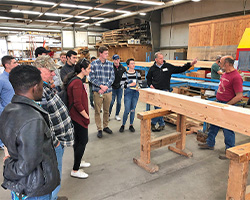SUNY ESF
Program Profile Paul Crovella
Staying Competitive
By Judy Gelman Myers
 In 2002, the US Department of Energy launched the Solar Decathlon competition, challenging
students across the country to create efficient, affordable buildings powered by renewables.
Since the competition’s inception, students in ESF’s Construction Management program
have led winning teams in multiple divisions.
In 2002, the US Department of Energy launched the Solar Decathlon competition, challenging
students across the country to create efficient, affordable buildings powered by renewables.
Since the competition’s inception, students in ESF’s Construction Management program
have led winning teams in multiple divisions.
ESF’s Construction Management program grew out of ESF’s Wood Products Engineering major. About forty years ago, the need for wood products declined, but many of the program’s graduates were hired as construction managers. In response, ESF introduced a construction management option, then a Construction Management degree.
In 2008, Paul Crovella ’16, PhD, was hired to infuse a green component into what he calls “a very traditional construction management program.” Under his guidance, the program emphasizes state-of-the-art methods that reduce the environmental impact of construction.
In the information-based future of construction management, integrated teams will work with shared 3D models throughout the process. The models serve as a digital database for 3D fabrication of sustainable building components. Said Crovella, “It’s the future of construction, and our students become very familiar with it through their coursework and participation in the Solar Decathlon.”
 That familiarity takes money. The program’s computer laboratory was state of the art
when it was installed in 2007, but is in need of upgrading to handle current technology.
Similarly, covering expenses to compete in a national competition in Boulder, Colorado
comes with a significant price tag. Working hand-in-hand with the ESF College Foundation,
Crovella launched a fundraising effort to support these aspects of the program, as
well as a marketing campaign to spread the word about the program—a necessary effort
if the school wants to stay competitive with other construction management programs
in the area. For that, he’s turning to alumni. “We’ve been thinking about how to creatively
use the rich resource we have in our alumni,” said Crovella. “Some of it's financial,
but it’s also their work experience, their networks, and the vision they have for
the future. These are key to giving our students the best opportunity for success
in the industry.”
That familiarity takes money. The program’s computer laboratory was state of the art
when it was installed in 2007, but is in need of upgrading to handle current technology.
Similarly, covering expenses to compete in a national competition in Boulder, Colorado
comes with a significant price tag. Working hand-in-hand with the ESF College Foundation,
Crovella launched a fundraising effort to support these aspects of the program, as
well as a marketing campaign to spread the word about the program—a necessary effort
if the school wants to stay competitive with other construction management programs
in the area. For that, he’s turning to alumni. “We’ve been thinking about how to creatively
use the rich resource we have in our alumni,” said Crovella. “Some of it's financial,
but it’s also their work experience, their networks, and the vision they have for
the future. These are key to giving our students the best opportunity for success
in the industry.”
Crovella is also turning to faculty. George Kyanka, professor of construction, applied mechanics, and engineering for 52 years, now retired, made an initial donation and helped Crovella write a fundraising letter to donors. It said, “Come forward.”
 Come forward they did. In the last year, thanks to donor support, the endowment value nearly tripled. Much of that came from large donors, but Crovella was thrilled with the number of
individual donors who understood what the program was doing, knew it wouldn't be possible
for them to make a $10,000 or $15,000 donation, but went ahead and contributed what
they could. Almost one hundred alumni donated as part of the campaign. To Crovella,
that said something about the impact the program had on their careers.
Come forward they did. In the last year, thanks to donor support, the endowment value nearly tripled. Much of that came from large donors, but Crovella was thrilled with the number of
individual donors who understood what the program was doing, knew it wouldn't be possible
for them to make a $10,000 or $15,000 donation, but went ahead and contributed what
they could. Almost one hundred alumni donated as part of the campaign. To Crovella,
that said something about the impact the program had on their careers.
Said Crovella, “Our large donors stepped up and really made a difference in terms of the dollar amount, and I was very pleased with the broad support from the wide swath of alums who recognized the call, appreciated what they had received from ESF, and wanted to give something back. I’m extremely appreciative and very, very impressed.”
